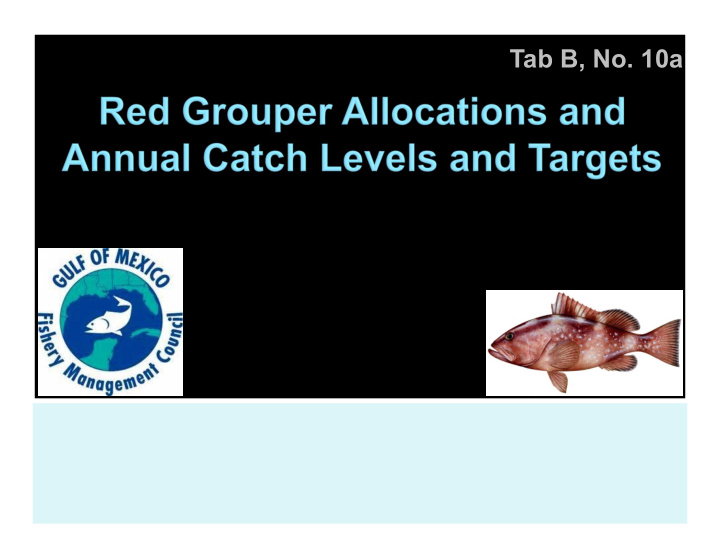



Tab B, No. 10a
Amendment 53 is being developed to revise the red grouper allocation between the commercial and recreational sectors and modify the total and sector ACLs based on results of the SEDAR 61 2019 stock assessment and subsequent OFL and ABC recommendations from the Council’s SSC. Acknowledging that the status quo sector allocations are based on the older and no longer used MRFSS data, the Council requested that the SSC examine alternative sector allocation scenarios considering the contemporary FES calibrated MRIP data. The SSC reviewed these scenarios in January 2020, and after affirming that the MRIP-FES recreational landings estimates represented the best scientific information available, recommended the projections included in Alternatives 2 - 4 of Action 2 as scientifically valid estimates of OFL and ABC.
Alternative 1: No Action – Maintain the sector allocations of the total ACL for Gulf red grouper between the commercial and recreational sectors. The allocation was derived from the average landings using Marine Recreational Fisheries Statistics Survey (MRFSS) data during the years 1986 through 2005, established in Reef Fish Amendment 30B. The allocations for red grouper are 76% commercial and 24% recreational. Alternative 2: Revise the sector allocations of the total ACL between the recreational and commercial sectors, as the average landings using Fishing Effort Survey-adjusted Marine Recreational Information Program (MRIP-FES) data during the years 1986 through 2005, based on the Southeast Fisheries Science Center (SEFSC) Annual Catch Limit (ACL) monitoring datasets. The allocations for red grouper are 59.3% commercial and 40.7% recreational.
Alternative 3: Revise the sector allocations of the total ACL between the recreational and commercial sectors, as the average landings using MRIP-FES data during the years 1986 through 2009, based on the SEFSC ACL monitoring datasets. The allocations for red grouper are 60.5% commercial and 39.5% recreational. Alternative 4: Revise the sector allocations of the total ACL between the recreational and commercial sectors, as the average landings using MRIP-FES data during the years 1986 through 2018, based on the SEFSC ACL monitoring datasets. The allocations for red grouper are 59.7% commercial and 40.3% recreational.
Alternative 1: No Action – Maintain the current OFL, ABC, ACLs, and ACTs with current commercial and recreational buffers between the respective catch limits and catch targets. The commercial buffer is 5%, and the recreational buffer is 8%. Alternative 2: Revise the OFL and ABC as recommended by the Scientific and Statistical Committee (SSC) and consistent with the allocation selected in Action 1. The stock ACL equals the ABC. Maintain the current buffer between the ACL and ACT for each sector. The commercial buffer is 5%, and the recreational buffer is 8%.
Alternative 3: Revise the OFL and ABC as recommended by the SSC and consistent with the allocation selected in Action 1. The stock ACL equals the ABC. Apply the ACL/ACT Control Rule to revise the buffer between the ACL and ACT for each sector. The commercial buffer is 0%, and the recreational buffer is 9%. Alternative 4: Revise the OFL and ABC as recommended by the SSC and consistent with the allocation selected in Action 1. The stock ACL equals the ABC. Maintain the current buffer between the ACL and ACT for the commercial sector, and apply the ACL/ACT Control Rule to revise the buffer between the ACL and ACT for the recreational sector. The commercial buffer is 5%, and the recreational buffer is 9%.
The alternatives in Actions 1 and 2 result in a range of ACTs for the recreational sector. Based on the MRIP-FES data, historical catch rates are now higher than previously estimated. SERO will be presenting on predicted closure dates for the recreational sector, based on historical landings as well as the range of potential ACTs. The Council may choose to consider recreational management measures to address this.
Recommend
More recommend